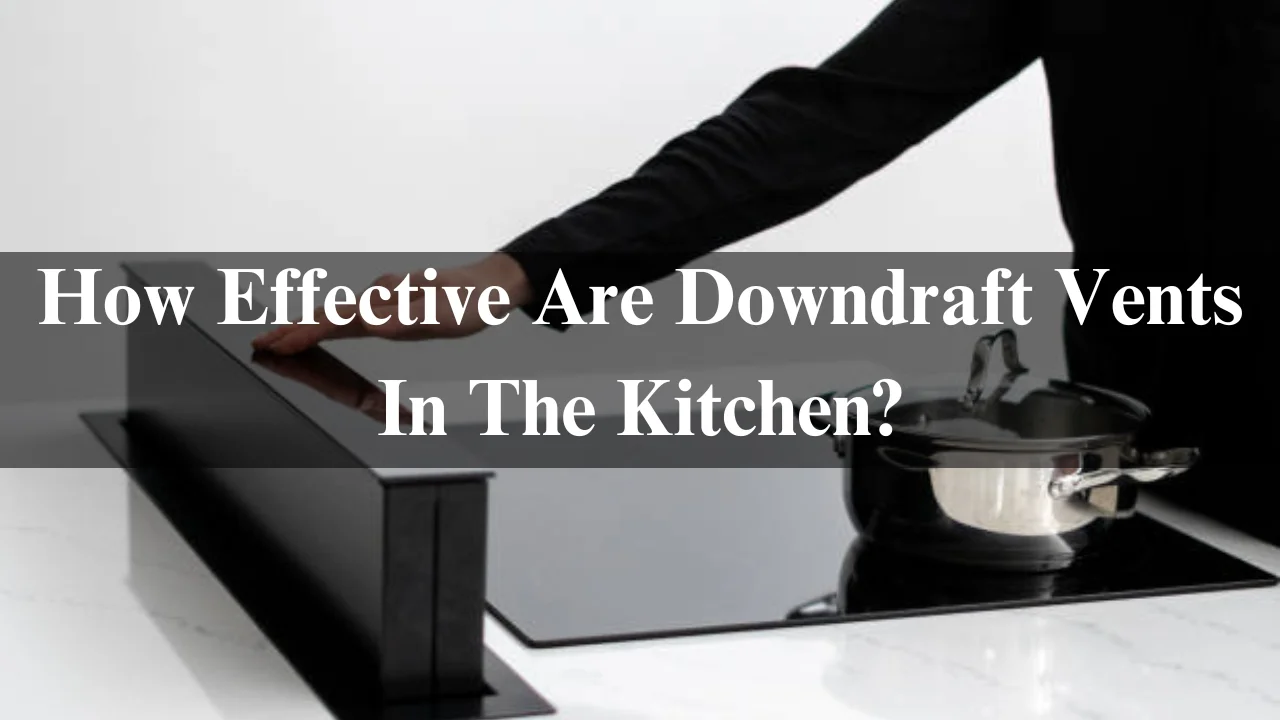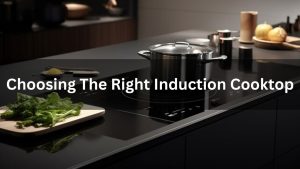Many homeowners find themselves at a crossroads when it comes to kitchen ventilation. Should they opt for the classic range hood or explore the sleek design of downdraft vents? With kitchens evolving into multifunctional spaces, it’s more important than ever to consider how air circulation affects both cooking and comfort.
Downdraft vents have surged in popularity, promising effective smoke and odor control without compromising aesthetics. But do they deliver on their promises? Let’s dive into the world of downdraft vents and uncover what makes them tick!
Table of Contents
What Are Downdraft Vents and How Do They Work?
Downdraft vents are innovative ventilation systems designed to keep kitchen air fresh while seamlessly blending with modern design. Unlike traditional range hoods that hang overhead, downdrafts sit discreetly behind the cooktop or within countertops.
Turning on a downdraft vent activates a fan that pulls smoke, steam, and odors downward through ducts. This airflow helps capture unwanted particles before they disperse throughout your kitchen. Many models feature adjustable heights, allowing them to rise above the cooking surface when needed.
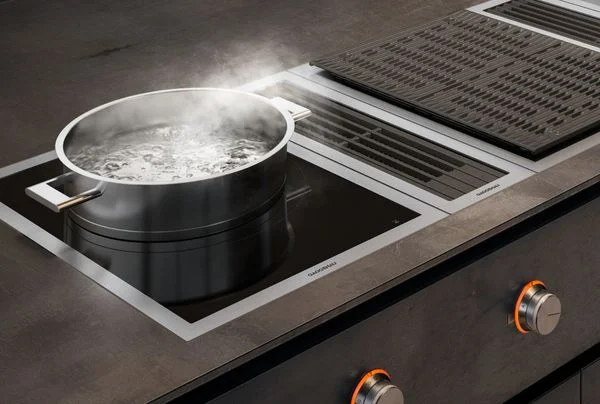
These vents often incorporate filters that can trap grease and other contaminants for easy cleaning. Their compact design makes them especially appealing in kitchens where limited space or aesthetics are paramount. With a combination of functionality and style, downdraft vents offer an attractive alternative for those looking to enhance their culinary spaces without sacrificing visual appeal.
Key Features of Downdraft Vents
Downdraft vents offer a sleek and modern solution for kitchen ventilation. One of their standout features is the ability to retract into the countertop when not in use. This design saves space while maintaining an open sightline in your kitchen.
Another key aspect is their effective smoke and odor capture. Positioned directly behind cooktops, they pull airborne particles downwards, preventing them from spreading throughout the room.
Many models come with adjustable fan speeds, allowing you to customize airflow based on cooking needs. The higher settings are perfect for frying or grilling, while lower speeds work well for simmering sauces.
Maintenance is also straightforward; most downdraft systems include removable filters that can be easily cleaned or replaced. This convenience ensures optimal performance without much hassle.
Various styles and finishes allow homeowners to choose options seamlessly integrating into any decor theme.
How Effective Are Downdraft Vents Compared to Range Hoods?
Downdraft vents offer a sleek alternative to traditional range hoods. They rise from the cooktop when needed, blending seamlessly into modern kitchen designs. However, their effectiveness often sparks debate.
While downdraft systems are convenient for maintaining sightlines and aesthetics, they typically have less airflow than standard range hoods. This can limit their ability to effectively capture smoke and odors.
Range hoods usually provide higher CFM (cubic feet per minute) ratings, translating to stronger suction power. This makes them particularly effective in intense cooking methods like frying or sautéing.
Downdrafts can suffice for light cooking tasks or simmering sauces. Their performance shines when space is premium and style precedes maximum efficiency. The choice between these options often hinges on individual needs and kitchen layouts.
Performance in Different Cooking Situations
When it comes to cooking, the type of dish often dictates how well a downdraft vent performs. For light sautéing or simmering, these vents can handle steam and odors with relative ease. Their compact design allows for discreet ventilation without overwhelming your kitchen space.
However, things change when frying is involved. The high heat and smoke from frying foods may push downdraft systems to their limits. Users might notice lingering smells or grease in the air since these vents aren’t as powerful as traditional range hoods.
Baking produces less airborne particles, making downdrafts more effective during those times. The gentle rise of warm air won’t trouble these systems much.
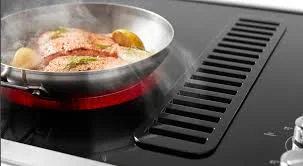
Investing in a robust range hood could be beneficial if you frequently prepare heavy-duty meals like stir-fries or deep-fried dishes. Each cooking situation demands efficient airflow and venting.
Comparing Airflow (CFM) of Downdraft Vents and Range Hoods
Airflow is a crucial factor in kitchen ventilation. This is typically measured in cubic feet per minute (CFM). Range hoods often boast higher CFM ratings than downdraft vents.
Range hoods can deliver anywhere from 300 to over 1200 CFM, depending on the model and type. They efficiently capture smoke, steam, and odors rising directly above the cooking surface. The design of range hoods allows for optimal suction power due to their placement and size.
On the other hand, downdraft vents usually offer lower CFM ratings—generally ranging from 200 to 600 CFM. These units pull air downwards rather than upwards. While they are effective at capturing some airborne particles during cooking, they may not be as powerful as traditional range hoods when dealing with larger amounts of steam or smoke.
For those who frequently cook at high temperatures or use methods that produce significant smoke—like frying or grilling—a more robust solution might be necessary. But if space-saving designs and aesthetics are your top priorities, downdrafts could still perform admirably within their limits.
Assessing your specific cooking habits will dictate which option suits you best. Balancing effectiveness with style can lead you toward a well-ventilated kitchen environment tailored just for you.
Efficiency Table
| Feature | Downdraft Vent | Range Hood |
| CFM (Airflow Power) | 500-600 CFM | 900-1200+ CFM |
| Noise Levels | Low to Medium | High (depending on model) |
| Best For | Light cooking, aesthetic kitchens | Heavy-duty cooking, large kitchens |
Can Downdraft Vents Handle Grease and Smoke Effectively?
Downdraft vents are designed to capture smoke and grease at the source, drawing them downward into the vent instead of letting them escape into your kitchen. This technology can be effective, but its performance largely depends on the cooktop’s height and placement.
In an ideal scenario, these vents work wonders for low-profile installations. They suck up emissions efficiently while you’re cooking, keeping your air cleaner than traditional overhead hoods in some cases.
However, if you’re frying or searing food that generates a lot of smoke, downdraft options may need help keeping up. Their suction power only sometimes matches that of high-output cooking methods.

Evaluating how often you engage in heavy-duty cooking will help determine if a downdraft vent is right for you. Consider your habits and preferences before deciding on your kitchen setup.
Grease Management
Grease management is a crucial factor when considering downdraft vents for your kitchen. Unlike traditional range hoods, which can effectively capture grease, downdraft systems face unique challenges.
These vents are designed to pull air downwards rather than upwards. This design can lead to less efficient grease capture since the airborne particles have more distance to travel before filtering out. Additionally, some models may need help with heavy cooking sessions that produce a lot of grease.
Regular maintenance becomes vital in this scenario. Cleaning filters and ducts frequently helps prevent build-up and reduces the risk of odors or smoke during cooking.
Investing in high-quality filters can also enhance performance. Look for options to handle grease more effectively while ensuring your kitchen remains fresh and clean after every meal preparation session.
Smoke Handling
Smoke can be a significant issue in the kitchen, especially during high-heat cooking. Downdraft vents are designed to tackle this challenge effectively.
When you cook with intense heat, smoke is inevitable. A downdraft vent pulls smoke down and away from your food preparation area, helping maintain better air quality while you work.
Their effectiveness largely depends on placement and airflow design. For optimal performance, they should be positioned as close to the cooking surface as possible.
However, not all downdraft systems are created equal. Some may struggle under heavy smoking loads or when frying foods at high temperatures.
Choosing a model with strong suction power can make a noticeable difference in handling smoke efficiently during those critical moments of culinary creation.
Are Downdraft Vents a Good Option for Island Cooktops?
Downdraft vents can be a game changer for island cooktops. They offer both style and functionality and are an attractive alternative to traditional hoods, keeping your kitchen sleek and open.
When cooking on an island, you often face challenges with grease and smoke rising directly overhead. Downdraft systems pull the air downwards effectively, capturing unwanted particles at the source. This means cleaner air while you whip up meals.
However, their effectiveness may vary depending on your cooking type. Heavy frying or grilling overwhelms some downdrafts due to their lower airflow capacity than conventional vent hood systems.
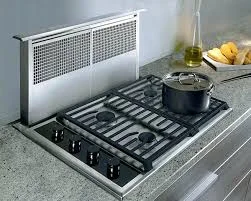
Another consideration is installation complexity; downdrafts require proper planning during kitchen design for optimal performance. While they offer distinct advantages in aesthetics and space-saving elements, weighing these factors is essential before deciding.
Advantages of Island Cooktops
Island cooktops bring a modern flair to any kitchen. They create an inviting space where family and friends can gather while meals are being prepared. Downdraft vents play a crucial role in maintaining this atmosphere.
One of the main advantages is that they eliminate the need for bulky overhead hoods. This opens up sightlines, making your kitchen feel more spacious and airy.
Another benefit is flexibility in design. With a downdraft vent, you can position your cooktop anywhere on the island without worrying about ventilation placement above it.
Additionally, these systems often feature sleek designs that complement contemporary aesthetics seamlessly.
Downdraft vents also offer powerful airflow options tailored for various cooking styles, ensuring smoke and odors dissipate quickly without hindering your culinary creativity.
Drawbacks for Island Cooktops
Downdraft vents present some challenges when used with island cooktops. One significant drawback is the limited suction power. Unlike traditional hoods with direct overhead placement, downdrafts may struggle to effectively capture all smoke and grease, especially during high-heat cooking.
Another consideration is noise. Many downdraft systems can be quite loud at higher settings. This might disrupt conversations or create an unpleasant ambiance in an open kitchen design.
Installation can also pose issues. Downdraft vents require adequate space beneath the counter for proper functionality, potentially complicating cabinetry arrangements.
Maintenance tends to be more involved, too. Grease buildup within these units demands regular cleaning to maintain efficiency, which can be cumbersome compared to range hood alternatives.
Aesthetics come into play; while sleek and modern, they often lack the dramatic visual impact of more conventional ventilation solutions.
Ventilation Path
The effectiveness of downdraft vents hinges significantly on their ventilation path. This system works by drawing air downwards, which means the placement and design of ducts play a crucial role in performance.
A well-designed ventilation path minimizes bends and turns to allow for efficient airflow. The shorter the distance from the cooktop to the exterior vent, the better it can handle smoke and grease. A straight shot to an outside wall is ideal.
It’s also essential that these ducts are appropriately sized according to local building codes and manufacturer specifications. If they’re too small or improperly configured, downdraft vents may struggle under heavy cooking conditions.
For kitchens designed with style as a priority—like those featuring island cooktops—the integration of downdraft systems can be visually appealing and functional when properly executed. Ensuring good installation with attention to ductwork will enhance efficiency dramatically.
When considering downdraft vents, it’s vital to evaluate how they fit into your kitchen’s overall design while ensuring optimal functionality through effective ventilation paths.
Installation Requirements for Downdraft Vents
Space and Venting Path
The first consideration when installing a downdraft vent is space. Unlike overhead range hoods, downdraft vents are typically installed behind or beside the cooktop. This setup requires a clear path to vent the air, often routed through the cabinetry and down to the floor. If your kitchen layout doesn’t offer sufficient space for this, installing a downdraft vent may be challenging.
Another critical factor is the venting path. Since downdraft vents pull air downwards and away, the air must be routed outside or into a filtration system. This means planning for ductwork, which can be tricky if you’re on an upper floor or have limited space behind cabinets.
Electrical and Plumbing Considerations
Most downdraft vents are electric and require a proper power source to function. Before installing one, ensure an outlet or wiring is in the area. If you’re remodeling, this step could involve bringing in an electrician to ensure the vent has a dedicated circuit.
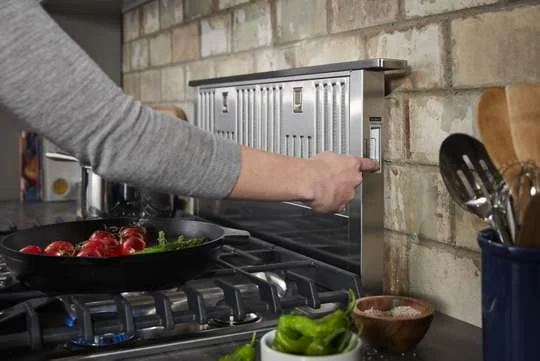
Additionally, while downdraft vents don’t usually involve plumbing, some systems may integrate with gas stoves or other utilities. Coordinating with your electrician and plumber is essential to avoid any installation issues.
What’s the Maintenance Like for Downdraft Vents?
Cleaning the Filters
One key aspect of maintaining downdraft vents is keeping the filters clean. Like any ventilation system, these vents have filters that trap grease, smoke, and food particles. Fortunately, most downdraft vent filters are removable and dishwasher-safe, making them relatively easy to clean.
For optimal performance, the filters should be cleaned every few months, depending on how frequently you cook. Neglecting this can reduce the vent’s effectiveness, as clogged filters restrict airflow and may cause the system to overheat.
General Upkeep
Beyond filter maintenance, you’ll also need to check the vent regularly for any blockages or malfunctions. Since downdraft vents pull air downward, they can sometimes accumulate debris, dust, or even grease in the ductwork. Conducting routine inspections and cleaning the ducts as needed will ensure your vent functions at its best.
Routine upkeep also extends the life of the motor and fan system, preventing costly repairs. Ensuring proper ventilation and regular cleaning will allow your downdraft vent to maintain strong airflow, keeping your kitchen air clean and odor-free.
Who Should Consider Installing a Downdraft Vent?
Ideal Scenarios for Downdraft Vents
Downdraft vents are most effective in kitchens with specific design needs. For instance, a downdraft vent can offer a minimalist solution if you have an island cooktop and don’t want a bulky overhead range hood disrupting your open layout. They’re also ideal for kitchens with low ceilings or where installing a traditional hood would obstruct windows or lighting fixtures.
Another scenario where downdraft vents shine is when aesthetic considerations are paramount. If you prefer a clean, uncluttered kitchen design, this type of vent seamlessly integrates into countertops, offering a more streamlined look.
When to Avoid Downdraft Vents
Despite their appeal, downdraft vents aren’t ideal for every kitchen. If you do a lot of high-heat cooking, such as frying or grilling, a downdraft vent may not be powerful enough to handle the smoke and grease. These vents are less effective at capturing fumes from tall pots or pans, as the air needs to be pulled downwards, which can be less efficient than an overhead hood.
Additionally, if your kitchen layout doesn’t offer an easy path for venting ductwork, or if you’re on a tight budget, downdraft systems might not be the best option. Installation can be more complex and costly than traditional range hoods, especially if ductwork needs to be rerouted.
Related Articles:
Are Downdraft Extractors More Effective In 2024?
Downdraft Cooktops Read All The Latest Pros And Cons 2024
Designing A Kitchen With A Downdraft Cooktop In 2024
Conclusion
In conclusion, while downdraft vents offer a sleek and space-saving kitchen ventilation solution, some may have better options. Their compact design is ideal for kitchens focused on aesthetics or where space is premium. However, a traditional range hood with higher airflow might provide better performance for those who cook frequently or use high-heat methods like frying. Ultimately, deciding between a downdraft vent and a range hood depends on your specific cooking needs and kitchen design preferences. Choose wisely to ensure the best balance of style and functionality in your kitchen.
FAQs
Can I retrofit a downdraft vent into an existing kitchen?
Yes, but significant changes to your cabinet space and ductwork may be required, which can be costly.
Are downdraft vents noisy?
They’re generally quieter than overhead range hoods, but noise levels depend on the model and fan speed.
Do downdraft vents work with all types of cooktops?
Downdraft vents are compatible with many cooktop styles but may be less effective with wide, multi-burner stoves.
How often should I clean the filters?
It depends on usage, but every few weeks is recommended, especially if you cook greasy foods regularly.

